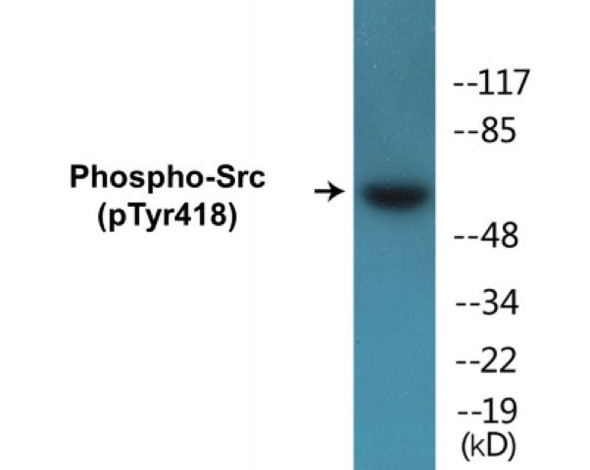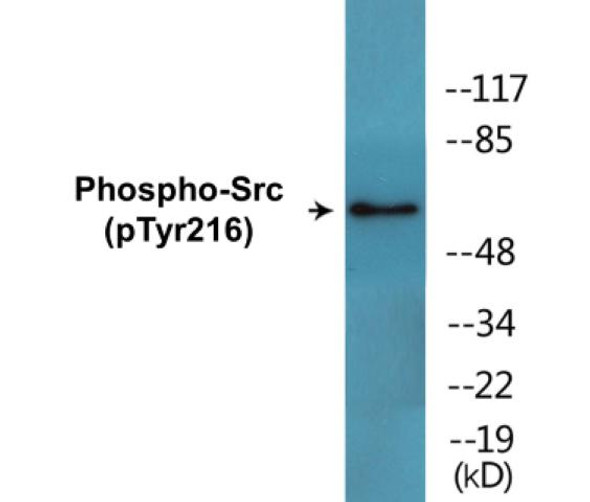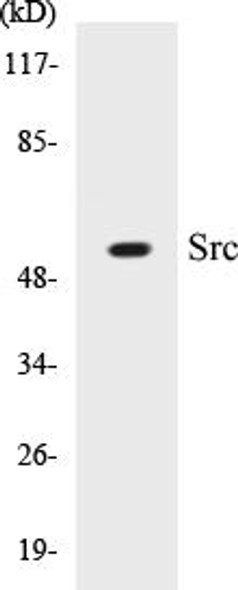Description
| Product Name: | Src (Phospho-Tyr418) Colorimetric Cell-Based ELISA |
| Product Code: | CBCAB00397 |
| ELISA Type: | Cell-Based |
| Target: | Src (Phospho-Tyr418) |
| Reactivity: | Human, Mouse, Rat |
| Dynamic Range: | > 5000 Cells |
| Detection Method: | Colorimetric 450 nm |
| Format: | 2 x 96-Well Microplates |
The Src (Phospho-Tyr418) Colorimetric Cell-Based ELISA Kit is a convenient, lysate-free, high throughput and sensitive assay kit that can detect Src protein phosphorylation and expression profile in cells. The kit can be used for measuring the relative amounts of phosphorylated Src in cultured cells as well as screening for the effects that various treatments, inhibitors (ie. siRNA or chemicals), or activators have on Src phosphorylation.
Qualitative determination of Src (Phospho-Tyr418) concentration is achieved by an indirect ELISA format. In essence, Src (Phospho-Tyr418) is captured by Src (Phospho-Tyr418)-specific primary antibodies while the HRP-conjugated secondary antibodies bind the Fc region of the primary antibody. Through this binding, the HRP enzyme conjugated to the secondary antibody can catalyze a colorimetric reaction upon substrate addition. Due to the qualitative nature of the Cell-Based ELISA, multiple normalization methods are needed:
| 1. | A monoclonal antibody specific for human GAPDH is included to serve as an internal positive control in normalizing the target absorbance values. |
| 2. | Following the colorimetric measurement of HRP activity via substrate addition, the Crystal Violet whole-cell staining method may be used to determine cell density. After staining, the results can be analysed by normalizing the absorbance values to cell amounts, by which the plating difference can be adjusted. |
| Database Information: | Gene ID: 6714, UniProt ID: P12931, OMIM: 190090, Unigene: Hs.195659 |
| Gene Symbol: | SRC |
| Sub Type: | Phospho |
| UniProt Protein Function: | Src: proto-oncogenic cytoplasmic tyrosine kinase of the SRC family. Highly expressed in certain fully differentiated cells such as neurons, platelets and macrophages. Phosphorylation of an activation loop tyrosine activates the enzyme; phosphorylation of a tyrosine in the C-terminus by Csk inhibits the enzyme. Two alternatively spliced isoforms have been described. |
| UniProt Protein Details: | Protein type:Oncoprotein; Protein kinase, tyrosine (non-receptor); Kinase, protein; EC 2.7.10.2; Protein kinase, TK; TK group; Src family Chromosomal Location of Human Ortholog: 20q12-q13 Cellular Component: neuron projection; mitochondrion; lysosome; postsynaptic density; actin filament; caveola; cytosol; extrinsic to internal side of plasma membrane; perinuclear region of cytoplasm; late endosome; mitochondrial inner membrane; cytoplasm; plasma membrane; nucleus Molecular Function:protein C-terminus binding; ephrin receptor binding; non-membrane spanning protein tyrosine kinase activity; phosphoprotein binding; insulin receptor binding; protein kinase activity; integrin binding; protein binding; enzyme binding; SH3/SH2 adaptor activity; protein kinase C binding; protein-tyrosine kinase activity; heme binding; estrogen receptor binding; SH2 domain binding; kinase activity; ATP binding; receptor binding; hormone receptor binding Biological Process: oogenesis; regulation of estrogen receptor signaling pathway; estrogen receptor signaling pathway; positive regulation of cyclin-dependent protein kinase activity; central nervous system development; progesterone receptor signaling pathway; nerve growth factor receptor signaling pathway; viral reproduction; regulation of cell cycle; positive regulation of apoptosis; positive regulation of transcription, DNA-dependent; uterus development; negative regulation of mitochondrial depolarization; negative regulation of protein homooligomerization; positive regulation of MAP kinase activity; cell-cell adhesion; transforming growth factor beta receptor signaling pathway; response to electrical stimulus; cell adhesion; bone resorption; response to drug; platelet activation; fibroblast growth factor receptor signaling pathway; activation of protein kinase B; response to virus; transcytosis; positive regulation of integrin activation; positive regulation of protein amino acid autophosphorylation; cellular response to insulin stimulus; response to mechanical stimulus; T cell costimulation; regulation of vascular permeability; negative regulation of transcription, DNA-dependent; leukocyte migration; negative regulation of apoptosis; axon guidance; peptidyl-tyrosine phosphorylation; protein amino acid autophosphorylation; platelet-derived growth factor receptor signaling pathway; negative regulation of caspase activity; signal transduction; positive regulation of smooth muscle cell migration; regulation of cell-cell adhesion; forebrain development; ephrin receptor signaling pathway; epidermal growth factor receptor signaling pathway; integrin-mediated signaling pathway; response to nutrient levels; regulation of bone resorption; negative regulation of focal adhesion formation; signal complex assembly; positive regulation of phosphoinositide 3-kinase activity; response to mineralocorticoid stimulus; cell cycle; regulation of cell proliferation; cell proliferation; positive regulation of protein kinase B signaling cascade; peptidyl-serine phosphorylation; response to hydrogen peroxide; regulation of protein binding; Ras protein signal transduction; stress fiber formation; innate immune response; response to acidity; positive regulation of insulin receptor signaling pathway; vascular endothelial growth factor receptor signaling pathway; blood coagulation; positive regulation of cytokine secretion |
| NCBI Summary: | This gene is highly similar to the v-src gene of Rous sarcoma virus. This proto-oncogene may play a role in the regulation of embryonic development and cell growth. The protein encoded by this gene is a tyrosine-protein kinase whose activity can be inhibited by phosphorylation by c-SRC kinase. Mutations in this gene could be involved in the malignant progression of colon cancer. Two transcript variants encoding the same protein have been found for this gene. [provided by RefSeq, Jul 2008] |
| UniProt Code: | P12931 |
| NCBI GenInfo Identifier: | 125711 |
| NCBI Gene ID: | 6714 |
| NCBI Accession: | P12931.3 |
| UniProt Secondary Accession: | P12931,Q76P87, Q86VB9, Q9H5A8, E1P5V4, |
| UniProt Related Accession: | P12931 |
| Molecular Weight: | 60kDa |
| NCBI Full Name: | Proto-oncogene tyrosine-protein kinase Src |
| NCBI Synonym Full Names: | SRC proto-oncogene, non-receptor tyrosine kinase |
| NCBI Official Symbol: | SRC |
| NCBI Official Synonym Symbols: | ASV; SRC1; c-SRC; p60-Src |
| NCBI Protein Information: | proto-oncogene tyrosine-protein kinase Src; proto-oncogene c-Src; tyrosine kinase pp60c-src; tyrosine-protein kinase SRC-1; protooncogene SRC, Rous sarcoma; v-src avian sarcoma (Schmidt-Ruppin A-2) viral oncogene homolog |
| UniProt Protein Name: | Proto-oncogene tyrosine-protein kinase Src |
| UniProt Synonym Protein Names: | Proto-oncogene c-Src; pp60c-src; p60-Src |
| Protein Family: | Proto-oncogene tyrosine-protein kinase |
| UniProt Gene Name: | SRC |
| UniProt Entry Name: | SRC_HUMAN |
| Component | Quantity |
| 96-Well Cell Culture Clear-Bottom Microplate | 2 plates |
| 10X TBS | 24 mL |
| Quenching Buffer | 24 mL |
| Blocking Buffer | 50 mL |
| 15X Wash Buffer | 50 mL |
| Primary Antibody Diluent | 12 mL |
| 100x Anti-Phospho Target Antibody | 60 µL |
| 100x Anti-Target Antibody | 60 µL |
| Anti-GAPDH Antibody | 60 µL |
| HRP-Conjugated Anti-Rabbit IgG Antibody | 12 mL |
| HRP-Conjugated Anti-Mouse IgG Antibody | 12 mL |
| SDS Solution | 12 mL |
| Stop Solution | 24 mL |
| Ready-to-Use Substrate | 12 mL |
| Crystal Violet Solution | 12 mL |
| Adhesive Plate Seals | 2 seals |
The following materials and/or equipment are NOT provided in this kit but are necessary to successfully conduct the experiment:
- Microplate reader able to measure absorbance at 450 nm and/or 595 nm for Crystal Violet Cell Staining (Optional)
- Micropipettes with capability of measuring volumes ranging from 1 µL to 1 ml
- 37% formaldehyde (Sigma Cat# F-8775) or formaldehyde from other sources
- Squirt bottle, manifold dispenser, multichannel pipette reservoir or automated microplate washer
- Graph paper or computer software capable of generating or displaying logarithmic functions
- Absorbent papers or vacuum aspirator
- Test tubes or microfuge tubes capable of storing ≥1 ml
- Poly-L-Lysine (Sigma Cat# P4832 for suspension cells)
- Orbital shaker (optional)
- Deionized or sterile water
*Note: Protocols are specific to each batch/lot. For the correct instructions please follow the protocol included in your kit.
| Step | Procedure |
| 1. | Seed 200 µL of 20,000 adherent cells in culture medium in each well of a 96-well plate. The plates included in the kit are sterile and treated for cell culture. For suspension cells and loosely attached cells, coat the plates with 100 µL of 10 µg/ml Poly-L-Lysine (not included) to each well of a 96-well plate for 30 minutes at 37°C prior to adding cells. |
| 2. | Incubate the cells for overnight at 37°C, 5% CO2. |
| 3. | Treat the cells as desired. |
| 4. | Remove the cell culture medium and rinse with 200 µL of 1x TBS, twice. |
| 5. | Fix the cells by incubating with 100 µL of Fixing Solution for 20 minutes at room temperature. The 4% formaldehyde is used for adherent cells and 8% formaldehyde is used for suspension cells and loosely attached cells. |
| 6. | Remove the Fixing Solution and wash the plate 3 times with 200 µL 1x Wash Buffer for five minutes each time with gentle shaking on the orbital shaker. The plate can be stored at 4°C for a week. |
| 7. | Add 100 µL of Quenching Buffer and incubate for 20 minutes at room temperature. |
| 8. | Wash the plate 3 times with 1x Wash Buffer for 5 minutes each time. |
| 9. | Add 200 µL of Blocking Buffer and incubate for 1 hour at room temperature. |
| 10. | Wash 3 times with 200 µL of 1x Wash Buffer for 5 minutes each time. |
| 11. | Add 50 µL of 1x primary antibodies Anti-Src (Phospho-Tyr418) Antibody, Anti-Src Antibody and/or Anti-GAPDH Antibody) to the corresponding wells, cover with Parafilm and incubate for 16 hours (overnight) at 4°C. If the target expression is known to be high, incubate for 2 hours at room temperature. |
| 12. | Wash 3 times with 200 µL of 1x Wash Buffer for 5 minutes each time. |
| 13. | Add 50 µL of 1x secondary antibodies (HRP-Conjugated AntiRabbit IgG Antibody or HRP-Conjugated Anti-Mouse IgG Antibody) to corresponding wells and incubate for 1.5 hours at room temperature. |
| 14. | Wash 3 times with 200 µL of 1x Wash Buffer for 5 minutes each time. |
| 15. | Add 50 µL of Ready-to-Use Substrate to each well and incubate for 30 minutes at room temperature in the dark. |
| 16. | Add 50 µL of Stop Solution to each well and read OD at 450 nm immediately using the microplate reader. |
(Additional Crystal Violet staining may be performed if desired – details of this may be found in the kit technical manual.)






